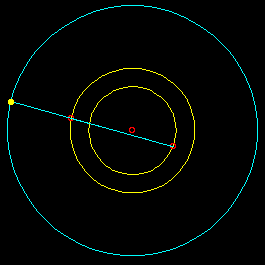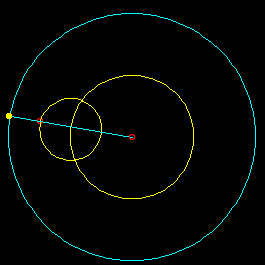
Planets occasionally appear to stand still or move backwards across the sky. The effect is produced when the Earth "overtakes" an outer planet.
The animation below shows the movement of two planets in the heliocentric view of the solar system. The Sun is in the centre. Two planets revolve around the Sun on the yellow circular orbits, the inner planet (the Earth) with a higher angular velocity than the outer planet. The light blue line indicates the firmament of the stars against which an observer on the inner planet projects the movement of the outer planet. The planet appears to stall when the inner planet passes (overtakes) the outer planet.
The same effect can be produced if the Earth is assumed to be at the centre of the planetary motion and the planets revolve around it on circular paths with "epicycles." An epicycle is a system with more than one circle. (This is the system of Eudoxus and Ptolemy.) In the simplest case a single circle moves with its centre on a second circle.
The second animation shows a planet revolving around the Earth (the red circle in the centre) on an epicycle: It moves on the small circle, which in turn moves on the large circle. An observer on Earth projects its location against the sky and sees the planet stall occasionally.


In the system shown by the lower animation the small circle is called the epicycle and the large circle the deferent. By tuning the circle sizes and rotation periods the epicycle system can produce apparent planetary movement virtually identical to the movement observed in the heliocentric system.
The system of Eudoxus was indeed an impressive achievement, particularly if it is recalled that the Greek scientists did not use a place-value number system. Calculations that the Babylonians did in an hour and the Indian mathematicians in even less took a whole day or longer in Greece. Eudoxus overcame this problem by introducing geometry into astronomy, which allows the derivation of relationships through drawn figures.